12.1 Social Behavior
Much human behavior is social behavior, that is, behavior that occurs in interaction with other people. Let’s look at social behavior in three types of settings, ranging from large to small:
Crowds: Large gatherings of people who do not necessarily know one another
Groups: Collections of people who know and communicate with each other, have distinctive roles (e.g., a group leader), and may work together toward a common goal
Close relationships: One-
on- one interactions in which you are in frequent contact with, and feel a strong connection to, another person
Crowds
Preview Questions
Question
 How does treating a crowd as a physical object help us understand behavior?
How does treating a crowd as a physical object help us understand behavior?
 How do we know that social norms—
How do we know that social norms—
 How does a crowd’s actual response to disaster square with how the media portrays it?
How does a crowd’s actual response to disaster square with how the media portrays it?
Would you kill someone to get a good seat at a concert? Your answer surely is no. How many of your friends would kill somebody to get a good seat at a concert? Your answer is probably zero. Who would kill someone just to get a good seat?
In Cincinnati in 1979, tragedy struck at a concert. Eleven people were killed by concertgoers trying to get a good seat for a show by the British rock band The Who.
How could this have happened? Were there 11 Who fans crazy enough to kill somebody to get a good seat? Was there one crazed murderer who needed seats for himself and 10 friends?
There is no evidence that the concert attracted any crazed murderers. It attracted normal people like yourself who wouldn’t choose to kill anybody; reports indicate that fans were “not riotous or violent” (The Who Concert Tragedy Task Force, 1980, p. 1). The culprit, then, was not any individual person. It was something bigger, with a force of its own: a crowd. The uncontrollable behavior of the crowd resulted in those 11 deaths.
Here is what happened. Seating at the concert was not reserved. Thousands of fans lined up ahead of time to get a good seat when the doors opened. There were few doors. As a result, a huge physical force, the crowd, propelled itself through a small physical space, the few doorways. “Rippling human waves of pressure knocked people down and rendered them helplessly trapped and fighting for breath” (http://www.crowdsafe.com/taskrpt/).
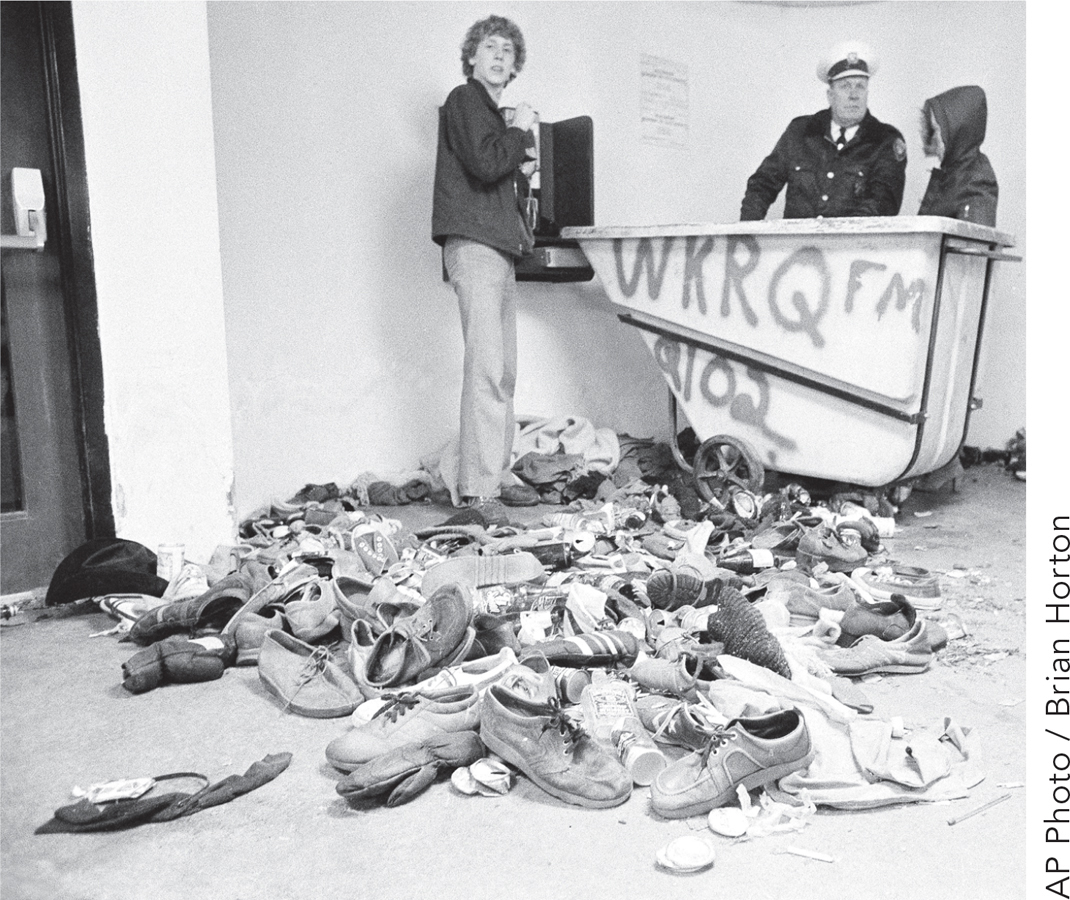
Unfortunately, this crowd disaster was not unique. About 2000 people a year die from being trapped in crowds (Hughes, 2003). Sometimes these tragedies are much larger in scope than the Who concert tragedy. In early 2006, roughly 1 million people were in Mecca, Saudi Arabia, for the Hajj, the annual Islamic pilgrimage. Crowding on a pedestrian bridge resulted in the death of 345 of these pilgrims, who were crushed, trampled, or suffocated (Murphy, 2006).
These tragedies teach us something important about people’s social behavior in crowds. The behavior cannot be explained in terms of the desires of the individual people in the crowd. No individual Who fan wanted to kill anybody. No individual person on the Hajj wanted anyone else to be trampled to death. The tragedies resulted from the action of the crowd as a whole.
How, then, can we begin to understand the force of the crowd as a whole? One way is to treat the crowd as a physical object.
THE PHYSICAL CROWD. People take up space. A big crowd of people thus requires a lot of space. If too big a crowd is crammed into too small a space, people can be squeezed so tightly that they will literally be unable to breathe. One way to understand the behavior of crowds and to avert crowd tragedies is to study the physical nature of crowds in tight spaces. This is what the government of Saudi Arabia concluded after the deaths of the 345 religious pilgrims in 2006.
When people watched videos of that tragedy, they saw that the crowding problem occurred at a very precise spot on the pilgrims’ path: a narrow “pinch point” (Murphy, 2006) on the overall route. Might the sheer physical force of the crowd at this particular point have caused the tragedy?
Have you ever been part of a crowd too big for a given space?
To find out, the Saudi government sought the advice of physicist Dirk Helbing (Helbing et al., 2014; Holden, 2007). In analyzing crowd flow through the physical layout of the Hajj route, Helbing developed an analogy: A human crowd is analogous to a fluid. Specifically, the flow of a crowd through walkways and bridges is like the flow of a liquid through trenches or pipes. Whether crowd flow is smooth or turbulent does not depend on the psychological characteristics of the individual people in the crowd. It depends on the rate of flow of the crowd as a whole and the space through which the crowd flows. If flow is too fast or the space is too small, flow—

The crowd-
THE PSYCHOLOGY OF THE CROWD. Treating a crowd as a physical object—
This possibility was addressed in one of the first works in the history of social psychology, by a nineteenth-
About a half-
THINK ABOUT IT
Have you ever been in a large crowd (e.g., at a concert or sporting event)? Once in the crowd, did you immediately lose your sense of self and act in an uncivilized manner? If not, what does that say about Le Bon’s theory?
If you are thinking like a psychological scientist, you are skeptical. Just because Le Bon and others said that anonymity causes crowd violence does not mean their conclusion is correct; you need to consider research findings. As it turns out, quantitative and qualitative research findings (Chapter 2) highlight factors other than anonymity. Let’s look at the quantitative (numerical) data first.
Many researchers have measured levels of aggression displayed by participants in two types of experimental conditions. In one, participants are made anonymous (e.g., by dressing them in oversized coats with hoods). In the other, they are identifiable (they wear regular clothing and name tags). People in both conditions have the opportunity to act aggressively; for example, they may deliver electric shocks to people in another room (Zimbardo, 1970). A summary of 60 such experiments did not support the view that anonymity increases aggression (Postmes & Spears, 1998). Rather, results highlighted a different psychological factor: social norms.
A social norm is a socially shared belief about the type of behavior that is acceptable in any given setting. In almost any setting, some types of behavior are acceptable or “normative,” whereas others are not. At a funeral, the norm is quiet, somber behavior. At a party, carefree, sociable behavior is normative. Norms often are not stated explicitly; instead, you learn them by observing others. In crowds, people learn social norms by observing others who are near them; they respond to “norms in the immediate social context” (Postmes & Spears, 1998, p. 254). If people near you in a crowd of political protesters are cursing loudly at government officials, you learn that it is acceptable to curse loudly in this setting, and you may do so, too. Crowds, then, affect behavior by defining local social norms.
What are the norms of the place where you are reading this book?
Qualitative data (information derived from interviews or written descriptions of behavior; Chapter 2) reveal a second cause of crowd violence, when it occurs. Some people in crowds intend to act violently. They do not lose their sense of self and ability to plan. Rather, they do plan—
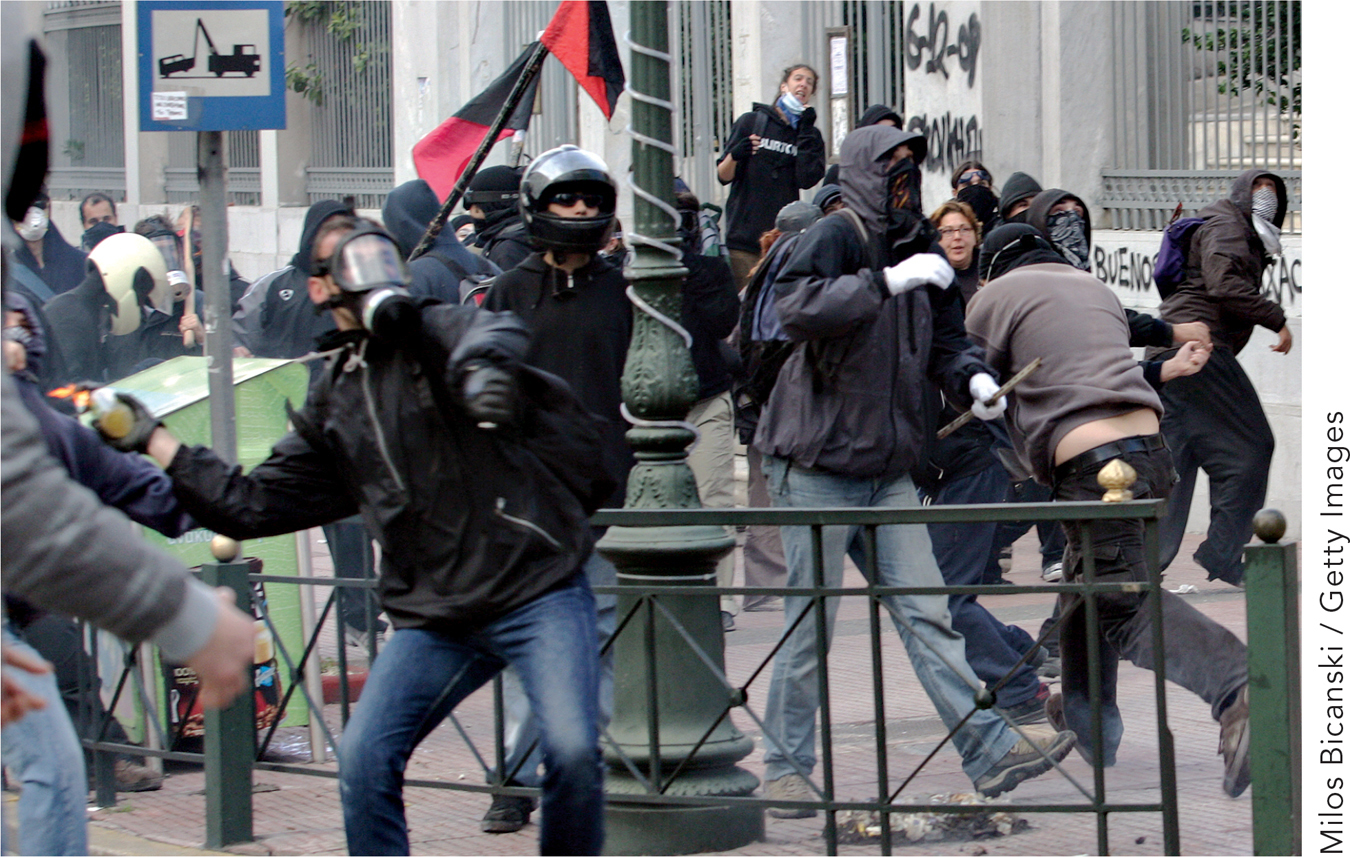
Think about how this finding conflicts with Le Bon’s explanation of crowd violence. Le Bon claimed that crowds cause peaceful people to become impulsively violent. But qualitative evidence shows that people who are not peaceful strategically choose to engage in violence in crowds.
CROWD RESPONSE TO DISASTER. Crowds often gather for a purpose: to hear a concert, cheer for the home team, or support a politician. Yet sometimes, people don’t intentionally gather at all. Instead, they are thrown together unexpectedly. People who previously had no shared purpose—
Many of us will never experience firsthand a disaster such as a plane crash, terrorist bombing, or natural catastrophe (earthquake, hurricane, etc.). Yet disasters are more common than you might think. An Internet service (http://hisz.rsoe.hu/alertmap/index.php?lang=eng) that details current disasters and emergencies worldwide lists, at the time of this writing, not just one or two disasters worldwide, but 15: 3 floods, 4 tropical storms or other cases of extreme weather, 5 disasters involving biological contaminants or the release of hazardous materials, 1 forest fire; 1 outbreak of an epidemic disease; and 1 explosion. How do people respond to such events?
One possibility is that they panic. Movies and TV programs sometimes show people responding to disasters by waving their hands in the air and screaming. Yet this is not what people usually do; evidence suggests that widespread panic is rare (Drury, 2004, p. 119). People usually follow instructions from authorities and help each other. Consider some examples:
In 1977 a fire engulfed a crowded supper club in Southgate, Kentucky. Interviews indicated that people behaved calmly. Employees of the club instructed guests how to reach safety and the guests followed their instructions. No evidence of panic was found (Johnston & Johnson, 1989).
During the 9/11 disaster, thousands of people who were in the World Trade Center when the planes struck poured into dark stairwells, their only route to safety. How did they act—
panicked, clawing over one another for survival? Not at all. Interviews indicate that people treated each other “like old friends.” They descended calmly, helping each other. One survivor reported a stranger saying to him, “You know, you look kind of tired, buddy, let me hold your jacket” (Ripley, 2008, p. 112). News reports from the 2013 Boston Marathon bombing indicate that, rather than fleeing the scene, large numbers of ordinary citizens remained there in order to help the injured. “The people on the street, the sidewalk volunteers, instead of running away, they stopped and … worked the people,” a physician reported (Langfield & Briggs, 2013, April 16). The area quickly turned into a relatively calm, orderly medical-
care site.

Why do people so often respond to disasters by helping rather than panicking? A crowd thrown together by a disaster develops a sense of “shared identity” (Drury & Cocking, 2007, p. 4). The disaster reminds them of something they otherwise might forget: that they are part of the human family, their fate bound together with that of neighbors, coworkers, and even complete strangers. They recognize that they must pull together—
Have you experienced unexpected kindness in an emergency?
WHAT DO YOU KNOW?…
Question 1
Which of the following is true of crowds?
Treating the flow of a crowd as analogous to the flow of liquid has allowed for the redesign of public places to avoid crowding disasters.
A. B. Research indicates that anonymity alone can account for increased aggression in crowds.
A. B. In crowds, people may be prompted to act according to local norms; if the norms are to behave aggressively, crowd violence can occur.
A. B. Crowd violence is often instigated by small groups who intend to act violently.
A. B. During disasters, widespread panic is quite common.
A. B.
Groups and Social Influence
Preview Questions
Question
 What is the minimum group size necessary for people to cave in to conformity?
What is the minimum group size necessary for people to cave in to conformity?
 How can you get someone to comply with a request?
How can you get someone to comply with a request?
 What are the implications of Milgram’s research on obedience to authority?
What are the implications of Milgram’s research on obedience to authority?
We now move from crowds to groups. This might not seem like much of a move, but it is. The psychological dynamics of crowds and groups differ.
Unlike crowds, the collections of people called groups generally know each other, communicate with one another, and share a common purpose. Group members often have well-
Social psychologists try to understand how group dynamics influence the behavior of individuals in the group. Research addresses three types of group influence: conformity, compliance, and obedience.
CONFORMITY. Conformity occurs when people alter their behavior to match the norms of a group (Cialdini & Goldstein, 2004). If you show up for your first day at work wearing jeans but notice everybody else is wearing a suit, deciding to dress in a suit the next day would be conforming to the group of employees at work.
In what situations have you conformed to fit in? When have you refused to conform?

Classic research by social psychologist Solomon Asch (1955) shows the power of conformity. Participants, upon arriving at Asch’s laboratory, joined a small group of people taking part in an experiment that supposedly was about visual perception. Across a series of 18 trials, they were shown a “standard line” and three “comparison lines” and were asked to judge which comparison line was the same length as the standard (Figure 12.1). People expressed their judgments out loud; group members, one at a time, indicated which line they thought matched the standard line.
Had you participated in this experiment, you would have found the task easy. On the first trial, one line clearly matches the standard, whereas the other lines differ. The experimenter goes around the room and everyone gives the same answer. On the second trial, the same thing happens: The perceptual task is easy and everyone gives the same answer. But on the third trial, something strange happens. It looks to you, a participant, as if one line obviously matches the standard and the others do not. Yet the first person who responds gives an answer that seems wrong. You think the person just made a mistake. Then the next person gives the same wrong answer. One by one, everybody gives that same incorrect answer. Next it’s your turn. What do you do? “Stick to your guns” and give the answer you believe is right, or conform to the group and give the answer everyone else did?
Participants faced this dilemma on 12 of 18 trials. Each time, all other participants gave the same answer, but it plainly was wrong. Did participants conform, that is, give answers that matched those of others in the group?
Before learning the results, you need to know a key piece of information. The other people—
Asch found that conformity—
Group size. In different experimental conditions, Asch varied the number of confederates from 1 to 15. Conformity reached its maximum with only three confederates. When there were only one or two confederates, almost all of the real research participants stuck to their own beliefs. But once three or more people answered incorrectly, participants conformed to those incorrect views about one-
third of the time; they gave the wrong answer even though the right answer was staring them in the face. The first lesson about conformity, then, is that even small groups create powerful pressure to conform.
Unanimity. In some studies, Asch eliminated unanimity. He instructed one confederate to give the right answer, while all the others answered incorrectly. With unanimity eliminated, conformity was greatly reduced. Even when only one other person in the group agreed with the participant, the participant was much less likely to conform.
The second lesson about conformity is that group pressures for conformity are greatest when the group is unanimous. When in a group—
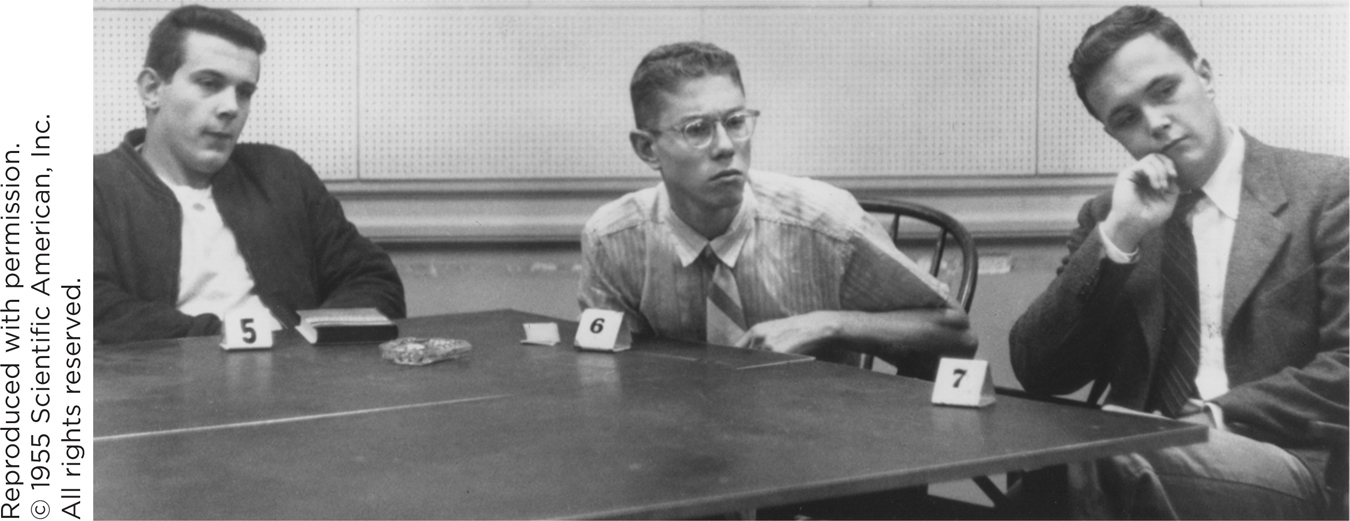
Remarkably, conformity occurred in Asch’s study even though group members (1) did not explicitly ask the participant to conform (they merely voiced their own answers) and (2) were not in a position of authority with respect to the participant (they seemed merely to be other people who signed up for the study). Group pressures may increase when people make explicit requests or are in positions of authority, as you’ll see below.
RESEARCH TOOLKIT
Confederates
Consider this classic social psychology study (Schachter & Singer, 1962). Pairs of people were invited to a lab room and were asked to complete a questionnaire that included the following items:
With how many men (other than your father) has your mother had extramarital relationships?
4 and under
5–
9 10 and over
List the childhood diseases you have had and the age at which you had them in the blank spaces below.
__________________________________________________
__________________________________________________
For which member of your immediate family is each of the following items most applicable? Please write the name of the family member in the blank space following the item.
Does not bathe or wash regularly. ___________________________________
Seems to need psychiatric care. ___________________________________
When seeing the items, one of the two people flew into a rage. “I get annoyed at this childhood disease question,” he said angrily. “I can’t remember what childhood diseases I had! … ‘Does not bathe or wash regularly’—that’s a real insult. … The hell with it!” he eventually said, “I don’t have to tell them all this.” The critical point here is that this happened every time the experiment was run: precisely the same rage, by the same person.
This person was a confederate, an accomplice of the experimenter who pretends to be a real research participant. Every time a real participant took part in the experiment, the confederate took part, too. His responses were the same every time because they were scripted by the experimenter as part of an “anger condition,” that is, a condition in which the real participant interacted with someone who was angry. In another experimental condition, a “euphoria” condition, the confederate was consistently happy and upbeat. By assigning participants randomly to the anger or euphoria conditions, the experimenters could determine the effect of a social cue—
In the history of social psychology, confederates have been used frequently. They enable researchers to overcome the conflict between two goals: (1) studying social interactions and (2) conducting research that is well controlled. Naturally occurring social interactions are out of the researcher’s control; once two regular people interact, almost anything can happen. But if one of the two is a confederate who looks, acts, and speaks in the same manner each time a participant takes part in a given experimental condition, the researcher gains experimental control.
One might object to the use of confederates because of the deception; the participants are being tricked. Some argue that the costs to participants of deception outweigh the benefits to research (Oliansky, 1991). Yet ethics boards that review research (Chapter 2) often judge that the scientific gains outweigh the costs and grant psychologists permission to use confederates.
In summary, when the social psychologist’s job is to create the seemingly impossible—
WHAT DO YOU KNOW?…
Question 2
Why is it difficult to maintain experimental control when studying social interactions? How do confederates solve this problem?
Conformity pressures also are influential when groups come together to make a joint decision. Pressure for conformity can produce groupthink, a decision-
COMPLIANCE. Everyday life bombards us with requests: donate to our charity; learn about our candidate; complete our survey; try our new energy drink. Often you just say no. But sometimes, you find yourself saying yes. You donate, take some campaign materials, complete the survey, or try a free sample of the drink. If you do, your actions are cases of compliance, behavior in which individuals agree to an explicit request.
When was the last time you complied with a request?
Social psychologists have identified techniques that increase compliance. One method is the foot-
The foot-
Why is foot-
Another compliance strategy uses distraction. When asked to comply with a request, people often have two reactions in sequence: (1) positive feelings about the request, because it supports a good cause, and (2) negative thoughts about it, because it requires an expenditure of time or money. The disrupt-
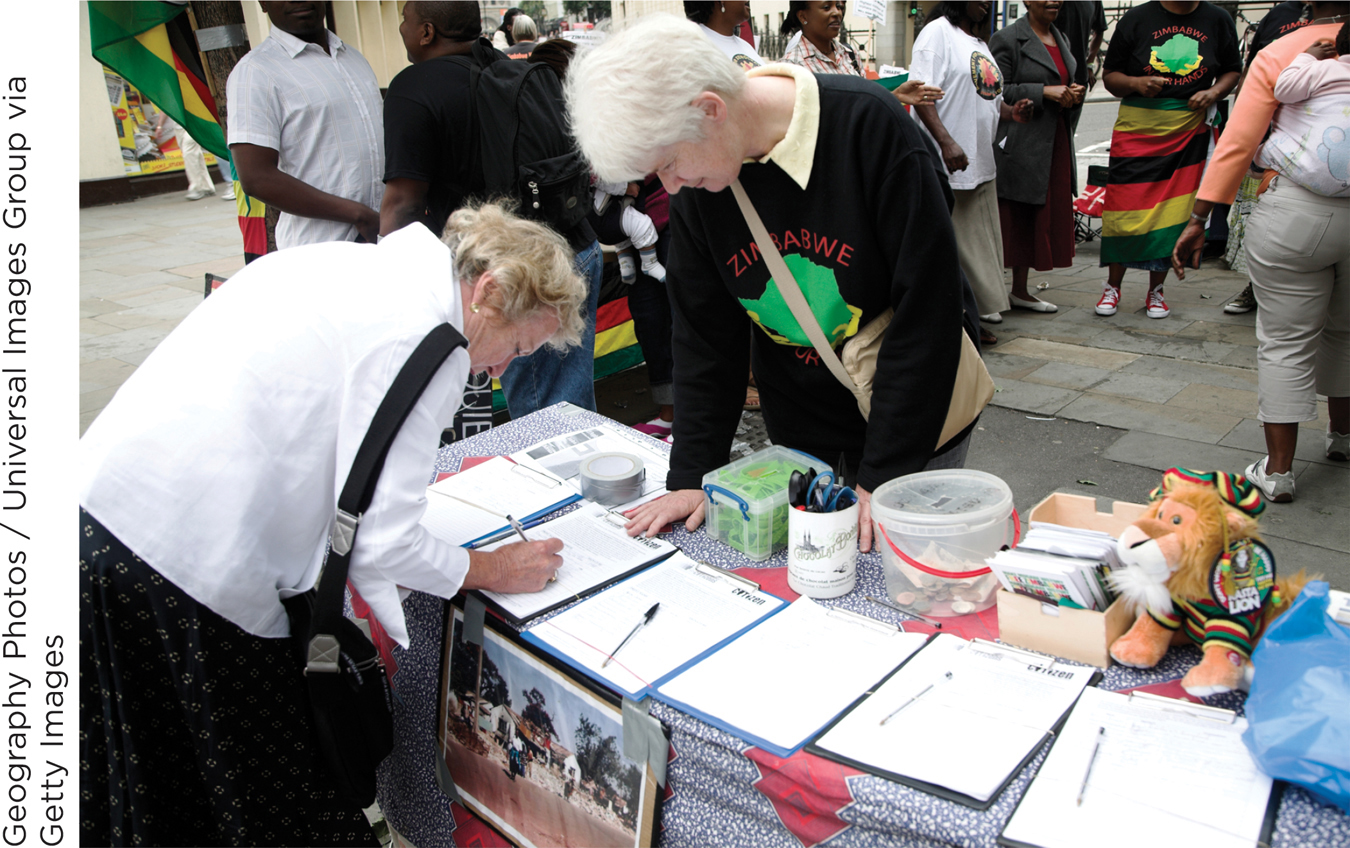
Compliance research has significant real-
OBEDIENCE. Research on conformity and compliance shows that ordinary people who hold no position of power can influence our behavior. What about people who are in positions of power? Their influence is explored in social psychological research on obedience, which occurs when people adhere to the instructions and commands of an authority figure.
Historically, social psychologists were motivated to study obedience by events of the past century. The twentieth century witnessed extraordinarily horrific genocides, such as the deaths of 800,000 Tutsis in Rwanda (1994), 1.5 million Armenians in Turkey (1915–
No one person can individually kill hundreds of thousands of others. For a genocidal system to work, a large number of people must participate. How are we to understand the actions of the thousands of people who played some role in these twentieth-
For the most part, no, these people weren’t crazed maniacs. Many would have described themselves as ordinary employees who were merely following the orders of their superiors. Consider one of the twentieth century’s most unforgettable images—
The social psychologist Stanley Milgram observed these trials and posed a scientific question: Why are some orders from authority figures so powerful that people will obey them even if it means harming or killing other human beings? He then devised experimental procedures to identify social determinants of obedience to authority. They proved to be the most compelling studies in the history of psychological science.
Before learning about the experimental procedures, first take note of Milgram’s question. He did not ask about the type of person who obeys orders. He asked about the orders themselves and the situation in which those orders are issued. Once again, then, we see a social psychologist reasoning that some social factors are so powerful that they can affect anyone.
Milgram’s experiment included three people: an experimenter, a research participant who was assigned the role of “teacher,” and a confederate who played the role of “learner” and acted according to a fixed script. In the study, the learner attempted to memorize a series of words. Whenever he made a mistake, the teacher (the real research participant) was instructed to punish him by delivering an electric shock, using the machine pictured here. As the learner made more and more mistakes (according to the script), the experimenter ordered the research participant to deliver stronger and stronger shocks. The dependent variable was the harshest punishment—
Milgram added three features to the experiment that were so extreme that one would probably expect everyone to refuse to follow the experimenter’s orders:
Punishments were severe. Shocks ranged from 15 to 450 volts, with the highest ones labeled “Danger: Severe Shock” and “X X X.”
The learner, a middle-
aged man, reported that he had a heart condition. As the shocks were delivered, the learner yelled out in pain and protested against the experimenter. Although seated in an adjacent room, his protests could be heard through the wall: “Let me out of here. My heart is bothering me. … Let me out of here! You have no right to keep me here!” During these protests, the experimenter calmly ordered the participant to “please continue. The experiment requires that you continue.” The learner’s protests continued until the teacher reached the 315-
volt mark, at which point the learner ominously fell silent.
Participants faced incredible stress. They had agreed to be in the experiment, and the authority figure running it was ordering them to go on. Yet a person was screaming in pain and demanding to be released from the study. Who would continue to deliver shocks to the learner in a circumstance like this?
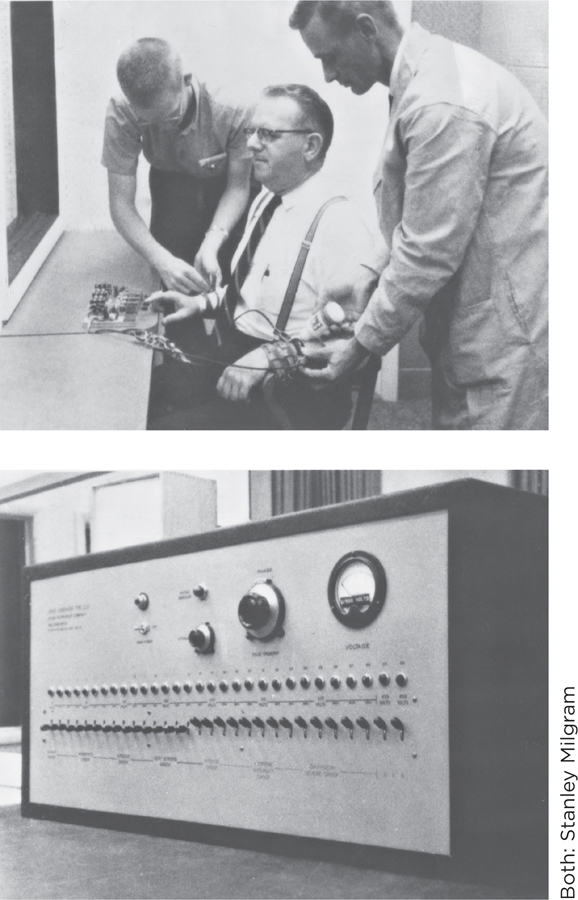
It turns out that most people would. In Milgram’s study, 26 of 40 participants—
Why? Did those participants not care about the learner? That’s not it. They cared a lot and, as a result, were under severe strain. “Tension,” Milgram reports, “reached extremes. … [S]ubjects were observed to sweat, tremble, stutter, bite their lips, groan, and dig their fingernails into their flesh” (1963/1971, p. 536). Yet the majority followed orders. Situational forces caused people—
Milgram’s results have profound implications. They show that people will obey authorities even when ordered to harm others, and even when the authority figure is merely an experimental psychologist. Real authority figures—
THINK ABOUT IT
Do you think Milgram should have been allowed to run his obedience to authority experiment? His participants were under tremendous stress; they thought they might have killed somebody! Does the knowledge gained from the experiment justify this cost to the participants?
“Maybe,” the optimists among you may be thinking, “this sort of brutality can only happen when someone is issuing direct orders. Otherwise, people would treat each other with kindness and respect.” Unfortunately, this sunny view of human nature is darkened by the social psychological research you’ll read about next.
WHAT DO YOU KNOW?…
Question 3
Match the concepts on the left with their description on the right.
1. Conformity 2. Unanimity 3. Groupthink 4. Compliance 5. Foot- 6. Disrupt- 7. Obedience | A decision- Adherence to instructions and commands of an authority figure A technique that uses distraction to increase compliance An agreement to an explicit request A variable that increased the probability that people in Asch’s study would conform Changing behavior to match group norms A technique in which a large request is preceded by a smaller request to increase compliance |
Question 4
A friend says, “Adolph Eichmann was a monster. Why else would he have played such an integral role in the killing of so many innocent people?” How might Milgram hope you would respond?
Roles and Group Identity
Preview Questions
Question
 Can wearing the uniform of a prison guard cause you to be abusive?
Can wearing the uniform of a prison guard cause you to be abusive?
 What force is powerful enough to reduce group rivalry?
What force is powerful enough to reduce group rivalry?
 When people don’t intervene during an emergency, is it because they are callous and uncaring?
When people don’t intervene during an emergency, is it because they are callous and uncaring?
“All the world’s a stage,” Shakespeare wrote. Of all the metaphors to describe human social life—
What roles will you play this week?
Everyday life resembles a play or movie (Scheibe, 2000). People have roles. A role is a set of behaviors that is expected of a person in a given situation. Here’s a simple example. When your psychology class meets, one person has the role of course instructor. Everyone expects a certain type of behavior from the person in that role: showing up on time for class, organizing class plans, doing a lot of talking once class begins. Maybe outside of class your professor is chronically late, disorganized, and quiet. But in class, in the role of course instructor, he or she likely is punctual, organized, and talkative.
ROLES AND THE STANFORD PRISON EXPERIMENT. How can one study the impact of roles experimentally? In everyday life, people differ not only in their roles in society, but in their personalities, intelligence, physical appearance, and many other qualities—
Stanford University psychologist Philip Zimbardo and his colleagues created such a society. It was a simulated prison. In the Stanford Prison Experiment (Haney, Banks, & Zimbardo, 1973; Zimbardo, 2007), 24 college students participated in what was planned as a two-
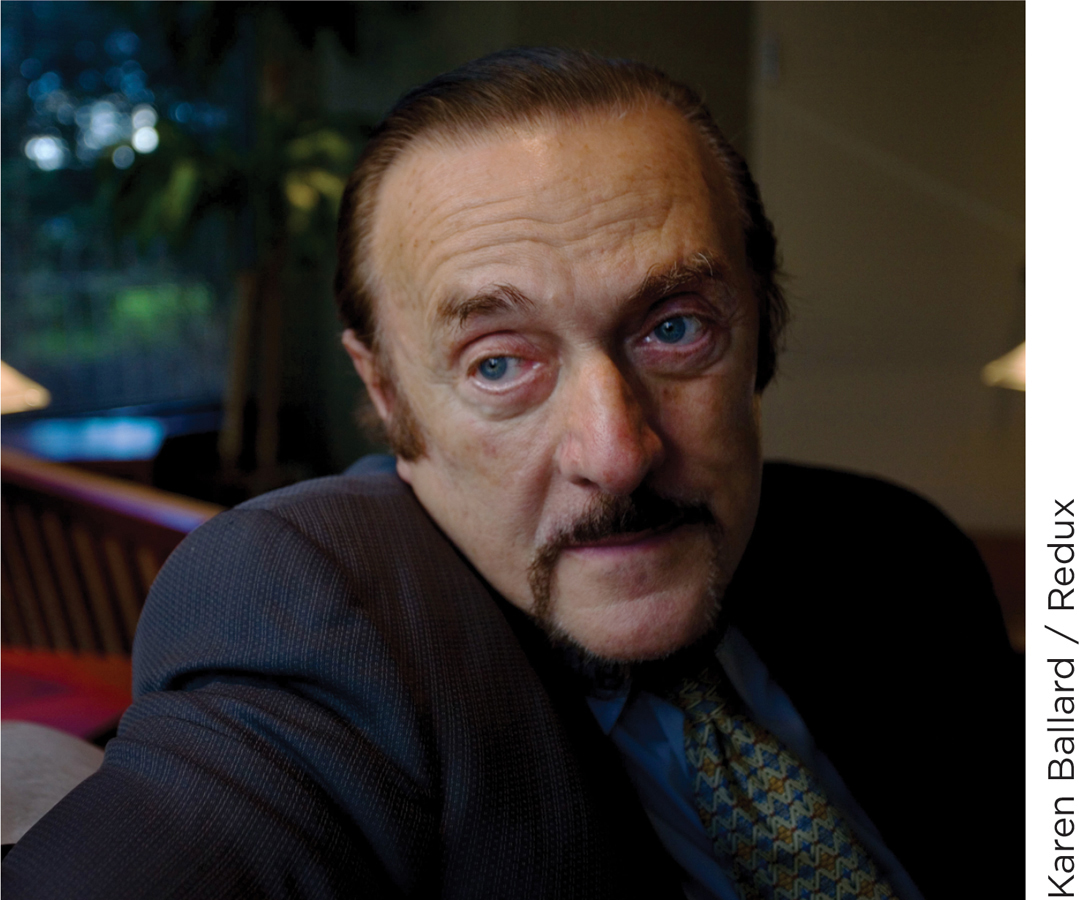
Zimbardo, the “Superintendent” of the prison, gave students little explicit information about their roles. He merely told the guards to maintain order and told the prisoners that, in the simulated jail, they were to be prisoners. Unlike the Milgram experiment, there were no specific orders about exactly how to act. In principle, prisoners and guards could have behaved however they liked; they could have spent the week just relaxing.
But that’s not what they did. Instead, students assigned to the role of guard treated prisoners in a “negative, hostile, affrontive, and dehumanizing” manner (Haney et al., 1973, p. 80). They belittled the prisoners. “I got tired of seeing prisoners in their rags and smelling the strong odors of their bodies” (p. 88), a guard reported. They abused prisoners physically. “I went to cell 2 to mess up a bed which the prisoner had made,” another guard reported, “and he grabbed me, screaming that he had just made it, and … I lashed out with my stick and hit him in the chin” (p. 88).
Students assigned to the role of prisoner behaved passively, seemingly accepting that the guards were in control. They experienced great stress from the guards’ abuse, with five prisoners having to be released from the experiment due to depression, anxiety, or bouts of crying. Prisoners reported personality changes. “I began to feel,” one said, “[that] I was losing my identity, that … the person who volunteered to get me into this prison [in other words, the person’s pre-
Eventually, the experiment spiraled out of control. Some prisoners staged a rebellion. Guards suppressed it forcefully. Afterward, guards treated prisoners even more harshly, compelling them to perform demeaning tasks, such as cleaning toilet bowls. Prisoners showed more and more signs of emotional disturbance. Finally, Zimbardo had to halt the experiment—
Why were the guards abusive and the prisoners passive? It can’t be due to their personalities, since people were assigned to their roles randomly; with a different flip of a coin, the guards would have been the prisoners and vice versa. Their differences in behavior, then, were caused by their different social roles. Once assigned to their roles, guards and prisoners knew how to act. From stories, movies, news reports, TV shows, and so forth, they understood the expected behavior of a guard and a prisoner, and their actions fit those expectations.
Zimbardo (2007) argues that the Stanford Prison experiment’s lessons extend to real-
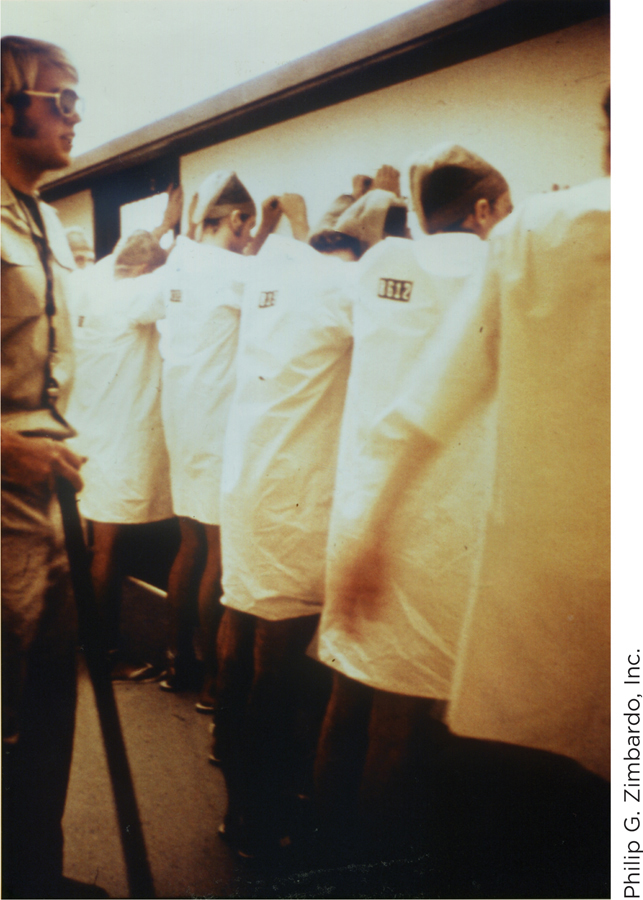
The Stanford Prison experiment has limitations. As the researchers themselves were aware (Haney et al., 1973), it was not a carefully designed study with multiple experimental and control conditions (see Chapter 2). It was merely a demonstration of the power of social factors over the behavior of individuals assigned to different roles. Zimbardo’s presence within the prison (as Superintendent) complicates interpretations of these factors. His behavior may have influenced participants in a manner that went beyond the effects of their assigned roles, per se (Griggs, 2014; Haslam & Reicher, 2003). Yet, even if so, the Stanford Prison experiment stands as a compelling demonstration of one of the major lessons of social psychology: the potential power of social forces over the behavior of ordinary people.
GROUP IDENTITY AND ROBBERS CAVE. Prisons are unusual—
Anecdotal evidence suggests that they do. Whatever group you are a part of—
Social identities are apparent in how people describe themselves. Self-
How do you describe yourself to others?
Group identities can form rapidly. Even people who have been members of groups for only a few days may strongly identify with their group and see others as rivals. A classic study by Muzafer Sherif and collaborators (1954), conducted at Robbers Cave State Park in Oklahoma, illustrates this. Sherif divided 22 fifth-
Sherif was able to eliminate the group rivalry as quickly as he created it. In the last week of camp, he presented challenges that could only be accomplished if the two groups worked together: He disrupted the camp water supply (which required the two groups to work together on repairs), told the boys that the camp couldn’t afford to rent a movie (which prompted the Rattlers and Eagles to pitch in money together), and caused a truck to become stuck in mud (with the boys literally pulling together to get it out). Working together toward shared goals transformed the groups. Former enemies became friends; they sang songs together and laughed about their earlier rivalry. By the time camp ended, the Eagles and Rattlers wanted to leave camp together, on one bus, and cheered when staff said they could.
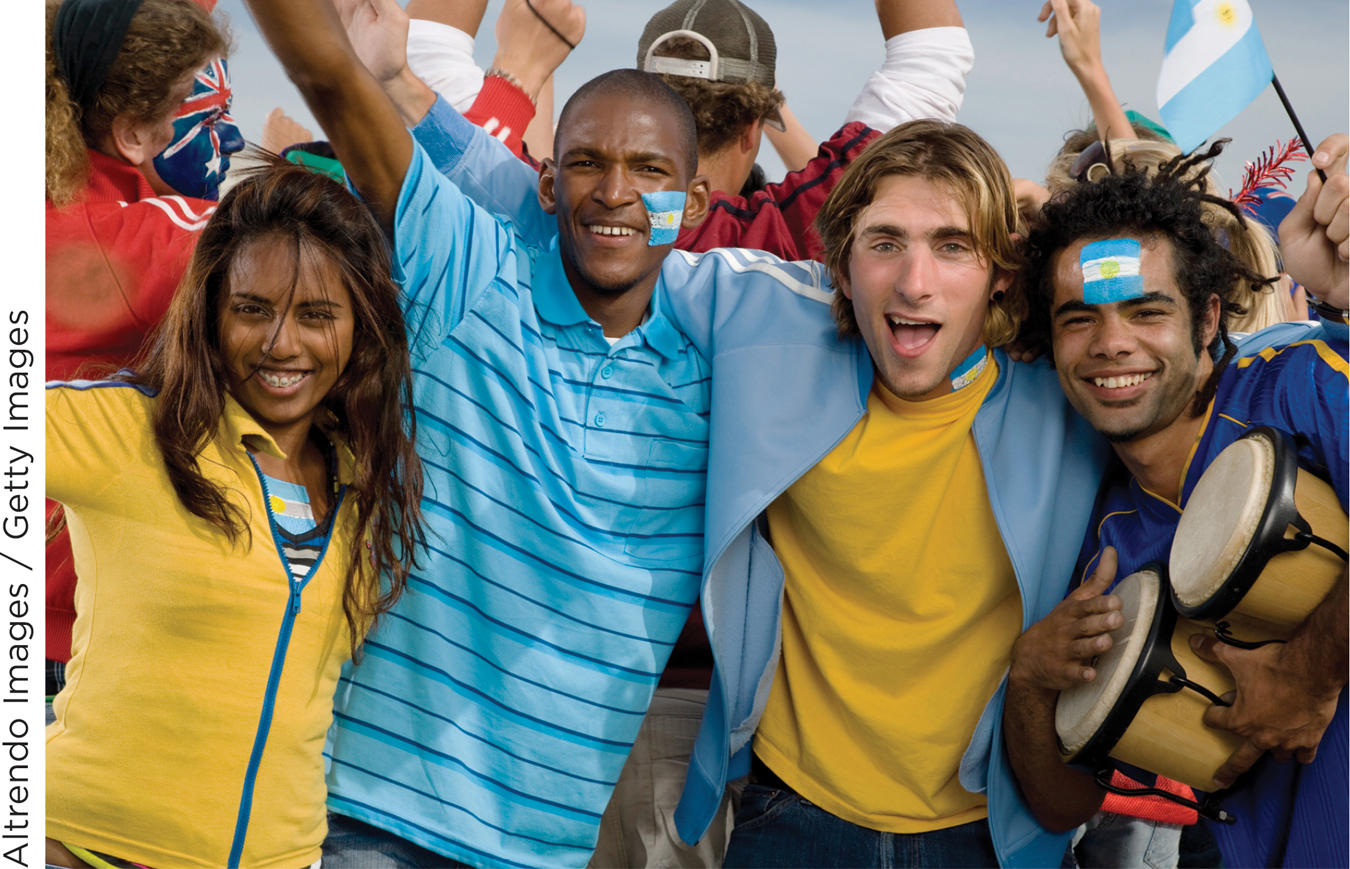
Sherif’s results have fascinating implications. They suggest that group rivalries can be reduced by having rivals work together toward a shared goal. History shows that shared goals foster a sense of unity. For example, the 9/11 tragedy enhanced American’s sense of national unity, as people realized that they needed to work cooperatively, as one big group, to achieve their aim of national security (Li & Brewer, 2004).
ROLE AMBIGUITY AND BYSTANDER INTERVENTION. The studies you’ve read about so far have something in common: Participants know their role. They are teachers or learners, prisoners or guards, Rattlers or Eagles. But sometimes we don’t know what our role is. If a friend is drinking heavily at a party, what is your role—
Research exploring this question was sparked by a tragedy in 1964. New York City resident Kitty Genovese was stabbed to death while returning home from work. Thirty-
Why did people just stand by instead of trying to help? Research on bystander intervention by John Darley and Bibb Latané (1968) suggests an answer. Darley and Latané invited participants to a discussion of issues in college life. The discussion took place through an intercom system; each participant could hear, but not see, the other participants, who were in nearby rooms. In reality, only one discussant was a real research participant; the others were confederates. During the discussion, the experimenters staged an emergency in which one of the confederates appeared to be having a seizure. “I’m-
Group size strongly influenced helping behavior (Figure 12.2). In bigger groups, there was a bystander effect: People were slower to intervene, and in many cases never intervened at all, when a lot of other bystanders were around. Half the participants assigned to six-
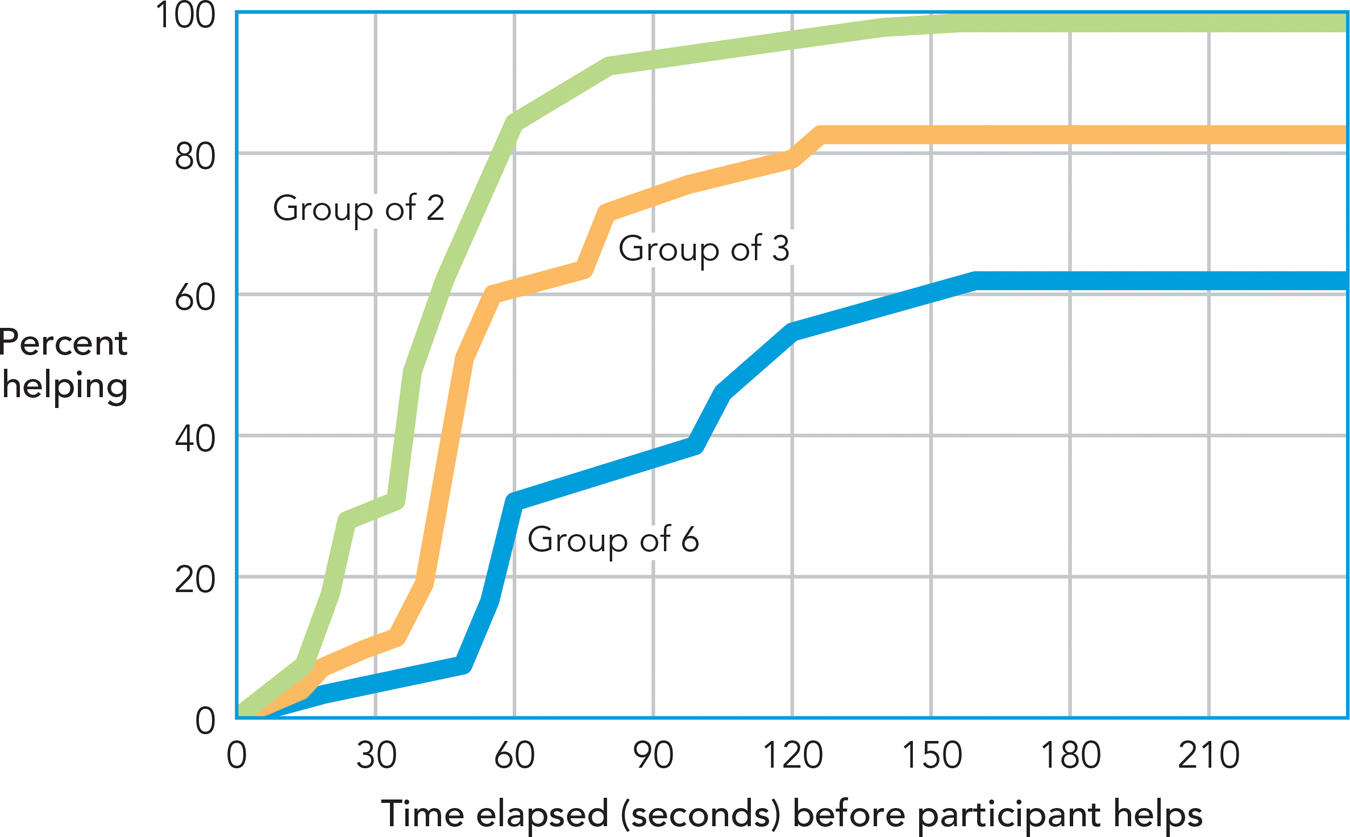
Why was group size so important? In emergencies, bystanders are aware of the people involved in the emergency and also the other bystanders in the vicinity. When there are no other bystanders, an individual knows that he or she is the only person who can provide help. But when lots of bystanders are around, one of them might provide assistance. The presence of other bystanders creates a diffusion of responsibility: lowered feelings of personal obligation to respond to someone in need, because others may respond. Larger groups diffuse responsibility and thereby lower people’s tendency to intervene.
Darley and Latané’s findings teach an important lesson. When hearing that city dwellers failed to respond to an emergency, one might conclude that city dwellers are callous and uncaring. But research indicates that the explanation is the situation, not the people. In big cities, there are likely to be more bystanders, more diffusion of responsibility, and thus less helping. No matter who you are, diffused responsibility causes you to be less likely to help.
WHAT DO YOU KNOW?…
Question 5
True or False?
In the Stanford Prison experiment, participants were not randomly assigned to the condition of guard or prisoner, so it is likely that their outrageous behavior was caused by the personalities of the people within each condition.
A. B. Philip Zimbardo, in applying the lesson learned from the Stanford Prison experiment, has pointed out that the behavior of the U.S. soldiers at Abu Ghraib prison in Iraq was the result of a “few bad apples.”
A. B. In the Robbers Cave study, campers were not randomly assigned to their groups (which they later named the Rattlers and Eagles), so it is likely that their eventual rivalry was caused by the personalities of the people within each group.
A. B. Ultimately, it was working toward shared goals that united the Rattlers and Eagles at Robbers Cave.
A. B. In Darley and Latané’s experiment on bystander intervention, the more participants there were available to help the person having a seizure, the faster any one person intervened to help.
A. B. One reason the bystander effect occurs is that the greater the number of people present, the greater the diffusion of responsibility.
A. B.
Close Relationships
Preview Questions
Question
 What is the most sure-
What is the most sure-
 To attract a mate, should you emphasize your psychological strengths or your physical attractiveness?
To attract a mate, should you emphasize your psychological strengths or your physical attractiveness?
 Is romantic love anything more than sexual passion? How long does it last?
Is romantic love anything more than sexual passion? How long does it last?
 How is love like a drug?
How is love like a drug?
Crowds and groups can affect your behavior. But the encounters that most affect your life as a whole are close relationships—those that involve frequent contact and strong psychological connections with another person (Kelley et al., 1983).
Some close relationships occur naturally. From birth, we are in the hands of parents and other caregivers, with whom our first close relationships are formed. Later in life, however, we have choices. We make friends with people we like, develop romantic relationships with people to whom we are attracted, and form committed relationships with people we love. Let’s look at the social psychology of liking and friendships, attraction and romantic relationships, and love and commitment.
LIKING AND FRIENDSHIPS. Look at Figure 12.3, a diagram of an apartment building. Which people, from which of the 10 apartments, do you think are most likely to be friends?

The question might sound ridiculous. How can you predict who will be friends before you know more about the individual people—
Where do your favorite friends live?
As it turns out, you can predict quite well. The big predictor, a team of social psychologists found, is physical distance (Festinger, Schachter, & Back, 1950). The people in the apartment complex shown in Figure 12.3 who tended to like each other and be friends were those who lived near each other; the building’s most common friendship pattern, by far, was that people were friends with their next-
A study of trainees at a police academy produced a similar result (Segal, 1974). The academy assigned seats in classrooms alphabetically, by last name. After their academy training, officers named their closest friends in the police force. Nearly half the time, they named people right next to them in the alphabet—
Why would physical distance have such a big effect? One explanation is mere exposure; people tend to like things more after they encounter them frequently (see the section on mere exposure and attitude change later in this chapter). We see the folks next door more frequently than the folks far away, and so we like them.
Proximity is not the only factor that affects liking, however. People also tend to like friends who support their opinions, help them to take part in activities they enjoy, and make them feel better about themselves (Finkel & Eastwick, in press). But one factor that reliably causes people to like each other is living next door.
ATTRACTION AND ROMANTIC RELATIONSHIPS. Some close relationships are just friendships. But others have that special spark: romance. What causes us to be romantically attracted to some people but not others?
To find out, social psychologists threw a party—
Which psychological quality do you think predicted attraction? As it turns out, none were strong predictors. But something else was: physical attractiveness. Unknown to students, as each entered the party, researchers rated their level of physical attractiveness. Physical attractiveness strongly predicted romantic attraction; if a dating partner was rated as highly physically attractive, students wanted to see that person again—
The party study shows what happens when people are paired randomly. But what happens when people have a choice? How do they select others to date? Most can tell, intuitively, that things might not work out if they pursue the singularly most attractive and popular person in town. People therefore tend to “match,” that is, to pursue dating partners whose level of physical attractiveness and popularity is similar to their own (Taylor et al., 2011). In the game of dating, people are strategic.
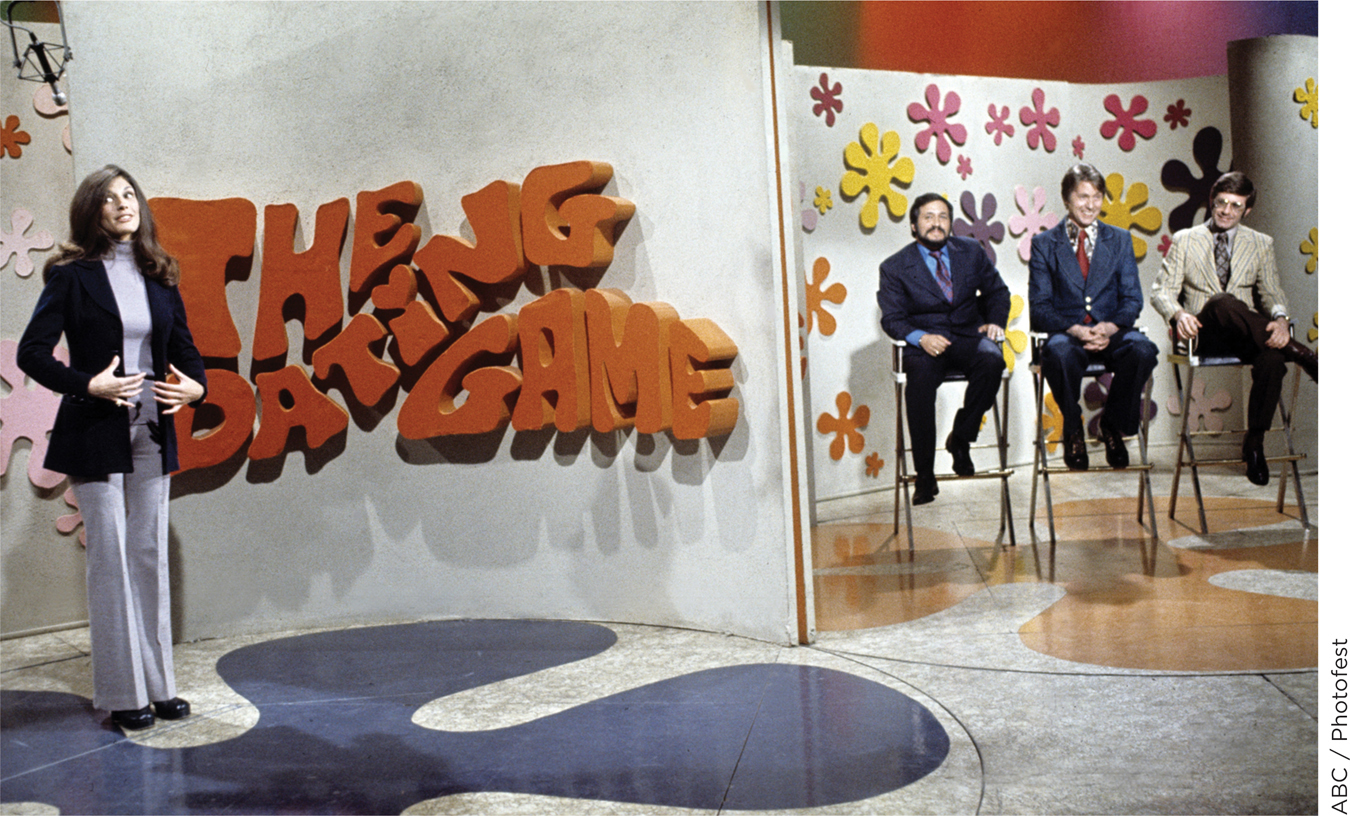
LOVE AND COMMITMENT. Sometimes the spark of romance triggers the enduring flame of love. Social psychology cannot unravel all the mysteries of love, but it can answer some questions. One asks: What is it—
To find out, psychologists asked a large group of people to rate whether each of a large number of psychological experiences is a component of love (Aron & Westbay, 1996). Statistical analyses of their ratings identified three main components of love: (1) euphoric and sexually aroused feelings of passion; (2) honest and supportive intimacy; and (3) loyal, devoted commitment (Table 12.1). Love, then, is more than romantic attraction; it includes deep commitment within a relationship that is open and supportive.
The relationships that we call “love” have three features: passion, intimacy, and commitment (Aron & Westbay, 1996). The table lists the psychological experiences that people most strongly associate with each.
12.1
| Components of Love | ||
|---|---|---|
|
Passion |
Intimacy |
Commitment |
|
Gazing at the other |
Openness |
Devotion |
|
Euphoria |
Feel free to talk about anything |
Commitment |
|
Butterflies in stomach |
Supportive |
Put other first |
|
Heart rate increases |
Honesty |
Need each other |
|
Sexual passion |
Understanding |
Protectiveness |
|
Sex appeal |
Patience |
Loyalty |
Can all three components of love last a lifetime? You may worry that passion is a flame that inevitably flickers out, even if intimacy and commitment remain. If so, then scientific evidence can calm your worry. Research shows that, for some lucky couples, the flames of passion burn for a lifetime. Both qualitative and quantitative evidence support this conclusion (Acevedo & Aron, 2009). When married couples are interviewed, qualitative analyses reveal substantial subgroups of couples who say that they are intensely, romantically in love, even after decades of marriage. When feelings are measured quantitatively, many long-
These happy marriages have major benefits. People in romantically successful marriages are happier with their life as a whole, enjoy better mental health, and even experience better physical health (Acevedo & Aron, 2009).
That last result might sound mysterious: Why would love cause people to feel better physically? Research has begun to unravel that mystery. In one study, participants were asked to rate the amount of pain they experienced when exposed to a very hot physical stimulus (Younger et al., 2010). While this was happening, the participants looked at pictures showing either (1) their romantic partner or (2) an equally attractive acquaintance. When viewing their romantic partner, participants were in less pain. Brain images taken during the study showed why. Pictures of the romantic partner activated the brain’s reward centers (i.e., neural systems involved in the processing of positive, rewarding stimuli). Activation of reward centers, in turn, directly reduces the experience of pain. Romantic love thus was like a pain-
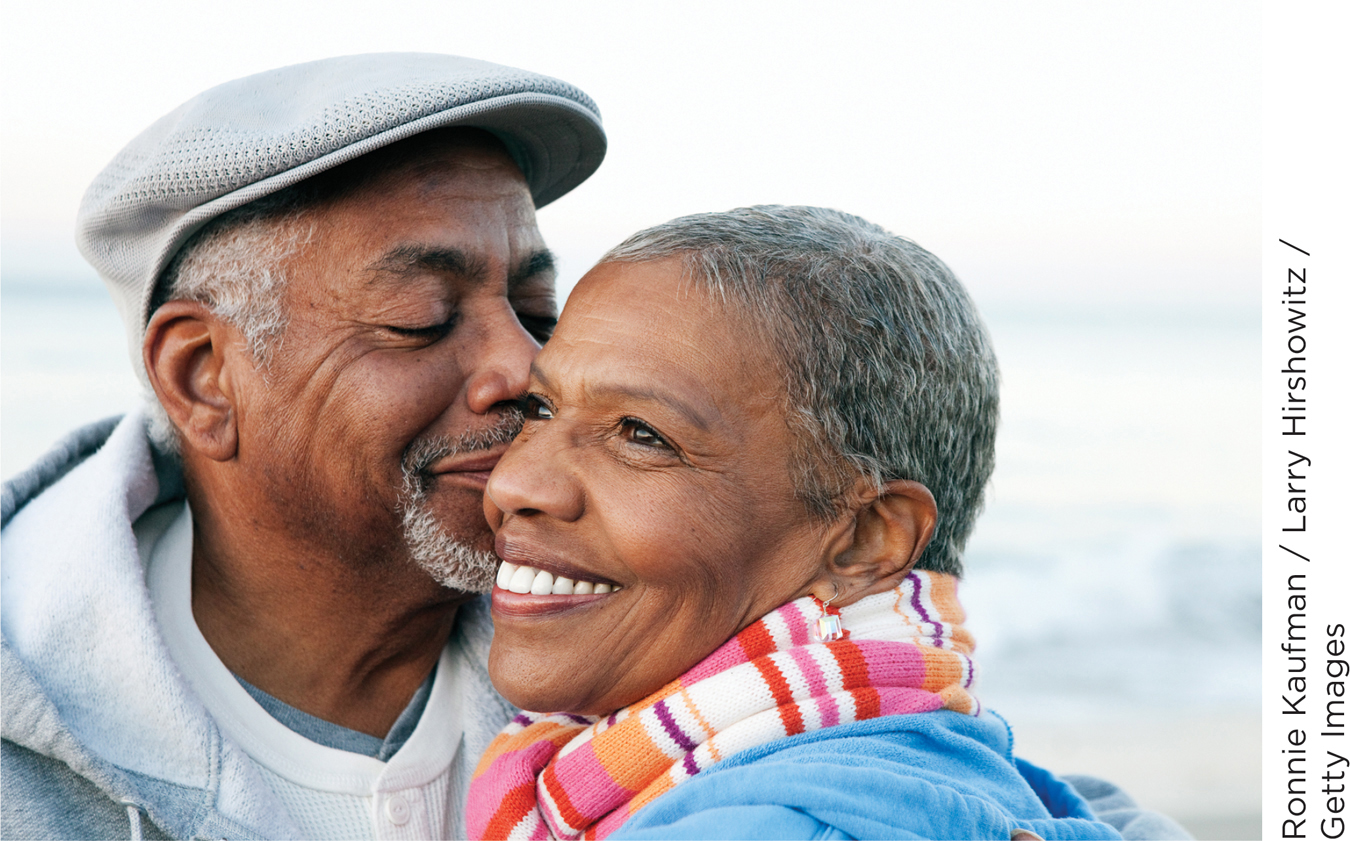
WHAT DO YOU KNOW?…
Question 6
Match the variable on the left with the outcome it predicts on the right.
1. Romantically successful marriage 2. Close physical distance 3. Physical attractiveness | Liking Physical health Romantic attraction |
TRY THIS!
Before you start the next section of this chapter, on social thinking (or social cognition), it’s time to do some thinking yourself. Go to www.pmbpsychology.com and try your hand at the Try This! activity for Chapter 12. Do it now, before we discuss it a little later in this chapter. ![]()